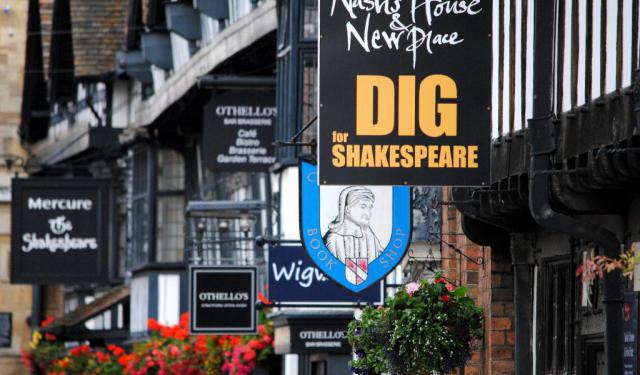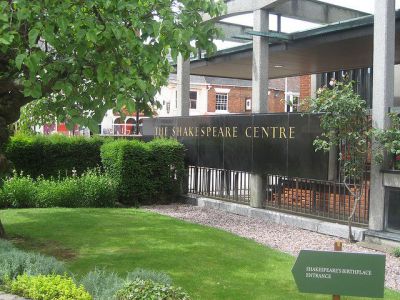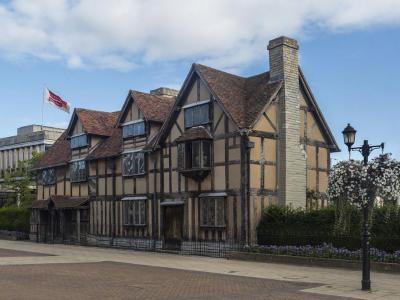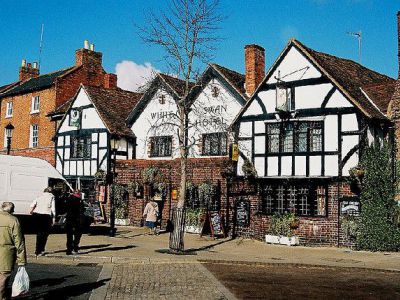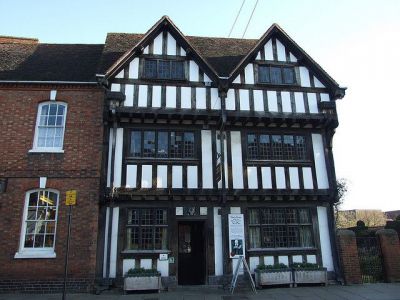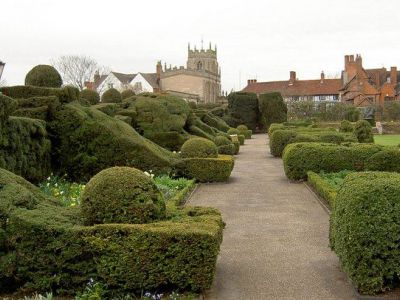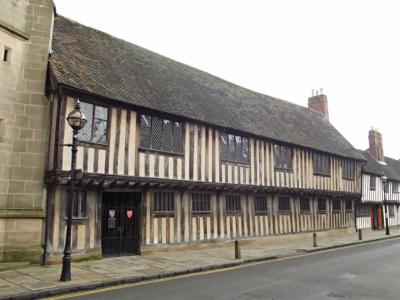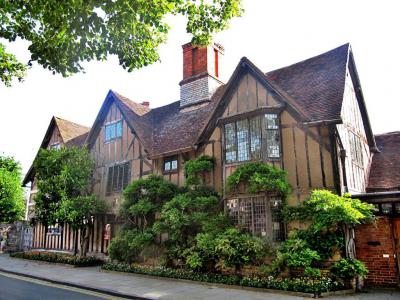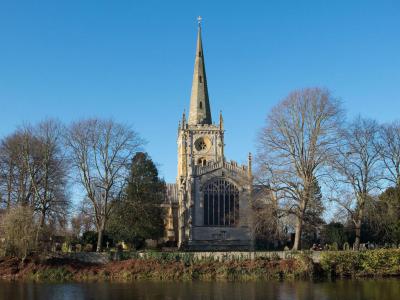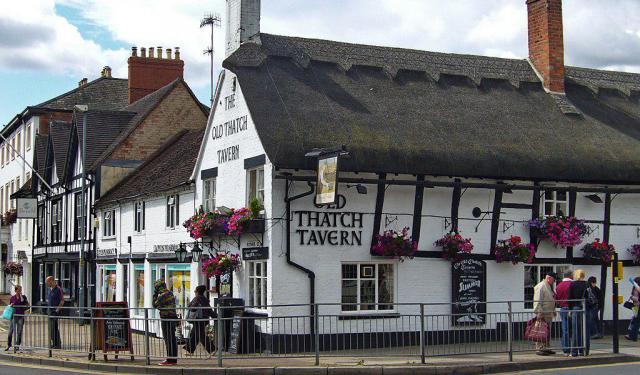William Shakespeare Walking Tour (Self Guided), Stratford-upon-Avon
The picturesque town of Stratford-upon-Avon is steeped in the history of William Shakespeare. Indeed, Shakespeare's hometown is where he was born and also where he passed away on the same day (23 April) 52 years later.
Many period locations in town, related to his and his family's life, are preserved as Britain's national heritage and visited by millions of people every year in a bid to celebrate Shakespeare's life and work.
But what exactly is there to see and how long should it take? The answer is about the same as how long is a piece of string! Here are some of the most popular Shakespearean sights in Stratford:
Shakespeare's Birthplace – a half-timbered Tudor family home in Henley Street, where the Bard was born in 1564.
Shakespeare's New Place – here Shakespeare lived in towards the end of his life; upon his death, New Place became the home of his daughter, Susanna Hall.
Nash House – the former dwelling of William Shakespeare's granddaughter, Elizabeth Hall; named after her first husband and original owner of the property, Thomas Nash.
Shakespeare's Schoolroom and Guildhall – here Shakespeare spent his school years and was inspired to become the world’s greatest playwright.
And of course, no trip to Stratford is complete without taking a short stroll to the Holy Trinity Church where William Shakespeare and his wife Anne Hathaway are buried.
If you wish to explore these and other prominent Shakespeare places independently and discover the buildings that the great man himself would have been familiar with as he went about his business back in the 16th century, take this self-guided walk!
Many period locations in town, related to his and his family's life, are preserved as Britain's national heritage and visited by millions of people every year in a bid to celebrate Shakespeare's life and work.
But what exactly is there to see and how long should it take? The answer is about the same as how long is a piece of string! Here are some of the most popular Shakespearean sights in Stratford:
Shakespeare's Birthplace – a half-timbered Tudor family home in Henley Street, where the Bard was born in 1564.
Shakespeare's New Place – here Shakespeare lived in towards the end of his life; upon his death, New Place became the home of his daughter, Susanna Hall.
Nash House – the former dwelling of William Shakespeare's granddaughter, Elizabeth Hall; named after her first husband and original owner of the property, Thomas Nash.
Shakespeare's Schoolroom and Guildhall – here Shakespeare spent his school years and was inspired to become the world’s greatest playwright.
And of course, no trip to Stratford is complete without taking a short stroll to the Holy Trinity Church where William Shakespeare and his wife Anne Hathaway are buried.
If you wish to explore these and other prominent Shakespeare places independently and discover the buildings that the great man himself would have been familiar with as he went about his business back in the 16th century, take this self-guided walk!
How it works: Download the app "GPSmyCity: Walks in 1K+ Cities" from Apple App Store or Google Play Store to your mobile phone or tablet. The app turns your mobile device into a personal tour guide and its built-in GPS navigation functions guide you from one tour stop to next. The app works offline, so no data plan is needed when traveling abroad.
William Shakespeare Walking Tour Map
Guide Name: William Shakespeare Walking Tour
Guide Location: England » Stratford-upon-Avon (See other walking tours in Stratford-upon-Avon)
Guide Type: Self-guided Walking Tour (Sightseeing)
# of Attractions: 8
Tour Duration: 1 Hour(s)
Travel Distance: 1.4 Km or 0.9 Miles
Author: DanaOffice
Sight(s) Featured in This Guide:
Guide Location: England » Stratford-upon-Avon (See other walking tours in Stratford-upon-Avon)
Guide Type: Self-guided Walking Tour (Sightseeing)
# of Attractions: 8
Tour Duration: 1 Hour(s)
Travel Distance: 1.4 Km or 0.9 Miles
Author: DanaOffice
Sight(s) Featured in This Guide:
- Shakespeare Center
- Shakespeare's Birthplace
- White Swan Hotel
- Nash House
- Shakespeare's New Place
- Shakespeare's Schoolroom and Guildhall
- Hall's Croft
- Holy Trinity Church
1) Shakespeare Center
The Shakespeare Birthplace Trust has mushroomed quite a bit since 1847 when the Trust acquired the Shakespeare Birthplace. The Trust was initially housed in the Birthplace but it soon began to acquire "stuff". Shakespeare related books, documents and manuscripts forced the Trust to successively move to other buildings close by.
By the late 1950s it was evident to all that an entirely new building was necessary. The focus would be on simplicity, with purpose connected to individual functions of different parts of the building. The building was officially opened on the 400th anniversary of Shakespeare's birth.
The Shakespeare Centre is used as a study center, public exhibition space, staff offices' library, archives and a reading room. below ground level there are safe rooms and climate controlled storage spaces.
The Centre will serve the administrative concerns of the staff and it is a center for Shakespeare studies. The Centre also has a Shakespeare-themed gift shop.
By the late 1950s it was evident to all that an entirely new building was necessary. The focus would be on simplicity, with purpose connected to individual functions of different parts of the building. The building was officially opened on the 400th anniversary of Shakespeare's birth.
The Shakespeare Centre is used as a study center, public exhibition space, staff offices' library, archives and a reading room. below ground level there are safe rooms and climate controlled storage spaces.
The Centre will serve the administrative concerns of the staff and it is a center for Shakespeare studies. The Centre also has a Shakespeare-themed gift shop.
2) Shakespeare's Birthplace (must see)
"A Mecca for all lovers of literature." That must be true, judging by all the "lovers of literature" signatures etched into the windows of the house on Henley Street. Years after William Shakespeare left the planet, his admirers came to say hello.
Charles Dickens, Sir Walter Scott, Thomas Carlyle, Lord Byron, Lord Tennyson, John Keats and last but not least, William Thackeray left their names. Here lived the Master of the English Language. What was it like, the house he grew up in? Was it rich, poor, middle class?
It is a very simple house today, but in Shakespeare's time it would have been thought a large dwelling. People were shorter, doors were lower, rooms were smaller. The house was effectively divided in two parts. One was for business and the other for living. Shakespeare's father, John, was a glove maker and a dealer in leather and wool.
It is a restored 16th century half-timbered house in Stratford-upon-Avon, Warwickshire, England. It is a museum now, but in 1564 it was where William Shakespeare was born. The house was constructed of wattle and daub around a timber frame. The fireplaces are of brick and stone and the ground floor is of flagstone.
William Shakespeare inherited the house but by then he had moved with his family to New Place on Chapel Street. Eventually the Henley Street house passed to other owners and by the 1800s it had fallen into a distressed state. In 1846 it was put up for sale. P.T. Barnum of circus fame tried to buy it and ship it "brick by brick" to the USA.
Not having any of that, the Shakespeare Birthplace Committee became the Shakespeare Birthplace Trust by an act of Parliament and stepped in to save the day. The Trust bought the property and restored it to its original state.
Next to the Birthplace is the Shakespeare Centre, a modern building which houses the Shakespeare Birthplace Trust. The Centre contains a library, and a collection of Shakespeare paraphernalia. The Centre also provides admission to the Birthplace.
Why You Should Visit:
William Shakespeare is the heart of this town.
Tips:
Don't worry about driving, parking, etc. There is a tram (good one) and most places to be seen are within walking distance of each other.
Charles Dickens, Sir Walter Scott, Thomas Carlyle, Lord Byron, Lord Tennyson, John Keats and last but not least, William Thackeray left their names. Here lived the Master of the English Language. What was it like, the house he grew up in? Was it rich, poor, middle class?
It is a very simple house today, but in Shakespeare's time it would have been thought a large dwelling. People were shorter, doors were lower, rooms were smaller. The house was effectively divided in two parts. One was for business and the other for living. Shakespeare's father, John, was a glove maker and a dealer in leather and wool.
It is a restored 16th century half-timbered house in Stratford-upon-Avon, Warwickshire, England. It is a museum now, but in 1564 it was where William Shakespeare was born. The house was constructed of wattle and daub around a timber frame. The fireplaces are of brick and stone and the ground floor is of flagstone.
William Shakespeare inherited the house but by then he had moved with his family to New Place on Chapel Street. Eventually the Henley Street house passed to other owners and by the 1800s it had fallen into a distressed state. In 1846 it was put up for sale. P.T. Barnum of circus fame tried to buy it and ship it "brick by brick" to the USA.
Not having any of that, the Shakespeare Birthplace Committee became the Shakespeare Birthplace Trust by an act of Parliament and stepped in to save the day. The Trust bought the property and restored it to its original state.
Next to the Birthplace is the Shakespeare Centre, a modern building which houses the Shakespeare Birthplace Trust. The Centre contains a library, and a collection of Shakespeare paraphernalia. The Centre also provides admission to the Birthplace.
Why You Should Visit:
William Shakespeare is the heart of this town.
Tips:
Don't worry about driving, parking, etc. There is a tram (good one) and most places to be seen are within walking distance of each other.
3) White Swan Hotel
A truly historic, black-and-white Tudor building of the White Swan Hotel has been ever faithful to the Stratford-upon-Avon picture perfect postcard since its construction in 1450. One of the few oldest preserved buildings in town, this was originally a bakery amongst whose faithful bread buyers, they say, were the Shakespeares. It started as an inn in 1560, and was first known as the King's House or Hall.
The Hall was owned by Robert Perrott, the brewer, and was kept by his brother William. In 1588, Roberts’s granddaughter Susanne Woodward married a young officer, called Richard Tyler, who happened to be one of William Shakespeare’s boyhood friends. Rumours have it that the Bard and the young couple would have had many a drink here, which is plausible, considering that Tyler had a passion for ales and was the son of an appointed Ale Taster for the borough.
Inside the hotel, in the oak room, there is a wall painting, commissioned by William Perrot in honour of his wife, dated around 1560. The painting depicts the story of Tobias and the Angel, and was discovered in 1927 during renovation. Chances are that, in his day, William Shakespeare could well sit here and enjoy his mead whilst looking at this very painting...
The Hall was owned by Robert Perrott, the brewer, and was kept by his brother William. In 1588, Roberts’s granddaughter Susanne Woodward married a young officer, called Richard Tyler, who happened to be one of William Shakespeare’s boyhood friends. Rumours have it that the Bard and the young couple would have had many a drink here, which is plausible, considering that Tyler had a passion for ales and was the son of an appointed Ale Taster for the borough.
Inside the hotel, in the oak room, there is a wall painting, commissioned by William Perrot in honour of his wife, dated around 1560. The painting depicts the story of Tobias and the Angel, and was discovered in 1927 during renovation. Chances are that, in his day, William Shakespeare could well sit here and enjoy his mead whilst looking at this very painting...
4) Nash House
Standing right next door to the ruins and gardens of New Place, the residence in which William Shakespeare spent his last living days, is Nash's House.
This classical Tudor-period dwelling was built around 1500 and was once owned and occupied by Thomas Nash, a distinguished lawyer. In 1626 he married Shakespeare’s granddaughter Elizabeth – the only daughter of Susanna Shakespeare. In 1637, Susanna bought the property and later bequeathed it to Elizabeth. After Nash’s death in 1647, it was reserved for their use and that of their heirs.
When Elizabeth died childless in 1670, the direct line of Shakespeare came to an end and the property came into the possession of her second husband John Bernard. In 1876, The Shakespeare Birthplace Trust acquired both New Place and Nash's House, and converted the latter into a museum of local history.
The museum traces lineage from the earliest settlers in the Avon Valley to the time of Shakespeare, and has a permanent exhibition on the life of Shakespeare as a father, husband, and resident of Stratford, as well as his writing career.
A fine example of 16th-century architecture, the house features period furnishing (many fine pieces of original Jacobean, Tudor and Elizabethan furniture), tapestries and engravings, and boasts a first-floor viewing platform overlooking the New Place site, the Guild Chapel and King Edward VI School, where Shakespeare was a student.
Exhibits inside include the executor's copy of Shakespeare's will, dated 1616, and a copy of the “fine” (a Tudor term for legal action) marking Shakespeare's purchase of New Place. One of the most intriguing objects on display is a gold signet ring with the inscription 'WS' – discovered near Holy Trinity Church, where Shakespeare's daughter Judith was married in February 1616.
This classical Tudor-period dwelling was built around 1500 and was once owned and occupied by Thomas Nash, a distinguished lawyer. In 1626 he married Shakespeare’s granddaughter Elizabeth – the only daughter of Susanna Shakespeare. In 1637, Susanna bought the property and later bequeathed it to Elizabeth. After Nash’s death in 1647, it was reserved for their use and that of their heirs.
When Elizabeth died childless in 1670, the direct line of Shakespeare came to an end and the property came into the possession of her second husband John Bernard. In 1876, The Shakespeare Birthplace Trust acquired both New Place and Nash's House, and converted the latter into a museum of local history.
The museum traces lineage from the earliest settlers in the Avon Valley to the time of Shakespeare, and has a permanent exhibition on the life of Shakespeare as a father, husband, and resident of Stratford, as well as his writing career.
A fine example of 16th-century architecture, the house features period furnishing (many fine pieces of original Jacobean, Tudor and Elizabethan furniture), tapestries and engravings, and boasts a first-floor viewing platform overlooking the New Place site, the Guild Chapel and King Edward VI School, where Shakespeare was a student.
Exhibits inside include the executor's copy of Shakespeare's will, dated 1616, and a copy of the “fine” (a Tudor term for legal action) marking Shakespeare's purchase of New Place. One of the most intriguing objects on display is a gold signet ring with the inscription 'WS' – discovered near Holy Trinity Church, where Shakespeare's daughter Judith was married in February 1616.
5) Shakespeare's New Place (must see)
In 1597 William Shakespeare was founder of the Lord Chamberlain's Men and a successful playwright. He had left his Birthplace House. He had moved to his newer, larger house, which he had bought for 129 pounds. The New Place (for so it was called) was located on Chapel Street, but a short walk from the Birthplace House on Henley Street.
New Place had been built in the 15th century by Hugh Clopton. The terms "New" or "Newer" as used in Britain are relative and not to be taken literally. One might say, "newer than the pyramids", for example. The New Place had a five gabled, three bayed, half-timbered frontage. Shakespeare rebuilt the frontage and added a gallery.
New Place was pulled down in the late 17th century by the Clopton family who had reacquired the property. The Clopton's newer New Place itself was demolished in 1759. Now New Place is occupied by a garden designed to memorialize Shakespeare's life and work and to allow visitors to develop their own connections with his legacy.
The Great Garden is behind the site where the house once stood. The garden shows sculptures based on Shakespeare's writings. The Knot Garden has been restored using designs which would have been familiar to Shakespeare himself.
New Place had been built in the 15th century by Hugh Clopton. The terms "New" or "Newer" as used in Britain are relative and not to be taken literally. One might say, "newer than the pyramids", for example. The New Place had a five gabled, three bayed, half-timbered frontage. Shakespeare rebuilt the frontage and added a gallery.
New Place was pulled down in the late 17th century by the Clopton family who had reacquired the property. The Clopton's newer New Place itself was demolished in 1759. Now New Place is occupied by a garden designed to memorialize Shakespeare's life and work and to allow visitors to develop their own connections with his legacy.
The Great Garden is behind the site where the house once stood. The garden shows sculptures based on Shakespeare's writings. The Knot Garden has been restored using designs which would have been familiar to Shakespeare himself.
6) Shakespeare's Schoolroom and Guildhall (must see)
Here is an interactive peek into William Shakespeare's childhood and schooling in the 16th century. The Guild of the Holy Cross built the Guildhall in 1420. Over the years more buildings were added, including a schoolhouse, a Chapel and Almshouses. The Guildhall was the headquarter of the Stratford Borough Council from 1553 and 1848.
When the Borough Council left for new digs at the Town Hall, they left the building to the school. The school, known as The King's New school, had been in the Guildhall since 1568. It later became the King Edward VI School (K.E.S.). Three years later seven-year-old William Shakespeare attended his first class. One may assume it was writing.
The school has been in continuous use by the local people since it first opened. The Guildhall has always been used and looked after and never neglected. Not only local students may study here, the school is also open to tourists. They may take an interactive class with William Shakespeare's teacher, Master Thomas Jenkins.
Adjoining the Guildhall is the Armoury. It was originally used a store place for arms, but after 1553 it became an administration center for the school. It also served as courtroom. On the first floor is the Master's chamber. In the center of the chamber is the prefect's table, bearing the names and initials of schoolboys through the years.
Students were mostly the children of wealthy middle class people. Williams' father, for instance, was the bailiff for the town. It was a public school and an entrance exam was required. Students did not pay fees, but they did have to provide their own firewood and candles. Classes frequently went from 6 am to 6 pm. There was a brief midday break.
Why You Should Visit:
to experience a bit how education used to be.
Tips:
When using the feather quill, be wary of ink blots.
When the Borough Council left for new digs at the Town Hall, they left the building to the school. The school, known as The King's New school, had been in the Guildhall since 1568. It later became the King Edward VI School (K.E.S.). Three years later seven-year-old William Shakespeare attended his first class. One may assume it was writing.
The school has been in continuous use by the local people since it first opened. The Guildhall has always been used and looked after and never neglected. Not only local students may study here, the school is also open to tourists. They may take an interactive class with William Shakespeare's teacher, Master Thomas Jenkins.
Adjoining the Guildhall is the Armoury. It was originally used a store place for arms, but after 1553 it became an administration center for the school. It also served as courtroom. On the first floor is the Master's chamber. In the center of the chamber is the prefect's table, bearing the names and initials of schoolboys through the years.
Students were mostly the children of wealthy middle class people. Williams' father, for instance, was the bailiff for the town. It was a public school and an entrance exam was required. Students did not pay fees, but they did have to provide their own firewood and candles. Classes frequently went from 6 am to 6 pm. There was a brief midday break.
Why You Should Visit:
to experience a bit how education used to be.
Tips:
When using the feather quill, be wary of ink blots.
7) Hall's Croft (must see)
Nearby to New Place was the house that William Shakespeare never lived in. Hall's Croft was the home of Susanna Shakespeare, William Shakespeare's daughter, and her husband, Doctor John Hall. Like New Place, Susanna's house had a flagstone floor. A stone floor was a sign of status. Most houses had earthen floors. The Halls were wealthy and they didn't mind showing it.
They owned fine furniture, heavy and strong, hand made from oak and very expensive. When Patients and other visitors entered the house, they understood the homeowner was someone to be respected. An enormous amount of work has been done on the house. The furniture appears authentic. But none of the original furniture remains.
The home contains a fine collection of 16th and 17th paintings. Doctor Hall is represented by his medical paraphernalia. Interesting to compare Jacobean medical practices to modern science. In the back of the house is a walled garden. The garden is maintained and it holds herbs and plants Doctor Hall might have used in his practice.
They owned fine furniture, heavy and strong, hand made from oak and very expensive. When Patients and other visitors entered the house, they understood the homeowner was someone to be respected. An enormous amount of work has been done on the house. The furniture appears authentic. But none of the original furniture remains.
The home contains a fine collection of 16th and 17th paintings. Doctor Hall is represented by his medical paraphernalia. Interesting to compare Jacobean medical practices to modern science. In the back of the house is a walled garden. The garden is maintained and it holds herbs and plants Doctor Hall might have used in his practice.
8) Holy Trinity Church (must see)
It is clear that Willam Shakespeare loved Stratford-upon-Avon. He was born in a house on Henley Street. The house was not far from Holy Trinity Church, where he was baptized, married and finally buried. He wanted to be always in the place where he arrived. He even has a plaque next to his burial place cursing anyone who would dare disturb his rest.
"...and cursed be he that moves my bones." To date, no one ever has. Many, many people have visited the Church, and looked at his effigy and read his plaque and wondered.
The Church dates from 1210. It stands on the site of an old Saxon monastery. It is, in fact, Stratford-upon-Avon's oldest building. John de Stratford founded a chantry here sometime in the 14th century. Dean Thomas Balshall rebuilt the chantry in 1491. Balshall is buried in the Church.
Within the church are several interesting items. There are: A 14th century porch knocker; more than twenty carved misericord seats in the chancel; The American window in Saint Peter's Chapel, donated by George Williams Childs, "The Gift of America to Shakespeare's Church"; and copies of Shakespeare's baptismal and burial certificates.
"...and cursed be he that moves my bones." To date, no one ever has. Many, many people have visited the Church, and looked at his effigy and read his plaque and wondered.
The Church dates from 1210. It stands on the site of an old Saxon monastery. It is, in fact, Stratford-upon-Avon's oldest building. John de Stratford founded a chantry here sometime in the 14th century. Dean Thomas Balshall rebuilt the chantry in 1491. Balshall is buried in the Church.
Within the church are several interesting items. There are: A 14th century porch knocker; more than twenty carved misericord seats in the chancel; The American window in Saint Peter's Chapel, donated by George Williams Childs, "The Gift of America to Shakespeare's Church"; and copies of Shakespeare's baptismal and burial certificates.
Walking Tours in Stratford-upon-Avon, England
Create Your Own Walk in Stratford-upon-Avon
Creating your own self-guided walk in Stratford-upon-Avon is easy and fun. Choose the city attractions that you want to see and a walk route map will be created just for you. You can even set your hotel as the start point of the walk.
Historical Tudor Houses Walking Tour
The first thing that strikes one walking across the medieval center of Stratford-Upon-Avon is the abundance of timber-framed Tudor houses. Their most notable feature, often combined with an overhanging upper story, is an exposed wooden framework; the rest is typically filled with brick, plaster or wattle-and-daub.
Many of these buildings have been kept in their original state, notably the... view more
Tour Duration: 1 Hour(s)
Travel Distance: 1.1 Km or 0.7 Miles
Many of these buildings have been kept in their original state, notably the... view more
Tour Duration: 1 Hour(s)
Travel Distance: 1.1 Km or 0.7 Miles
Stratford-upon-Avon Introduction Walking Tour
"Strat" is an Old English term derived from the Latin "Stratum", the word for street. A "ford" is a section of a stream where a crossing may be made. "Avon" is Celtic for river. Put them all together with links like a sausage and you have Stratford-upon-Avon. The ford actually exists. It is now marked by Clopton Bridge.
Primal Stratford was established by... view more
Tour Duration: 1 Hour(s)
Travel Distance: 1.9 Km or 1.2 Miles
Primal Stratford was established by... view more
Tour Duration: 1 Hour(s)
Travel Distance: 1.9 Km or 1.2 Miles
The Most Popular Cities
/ view all
